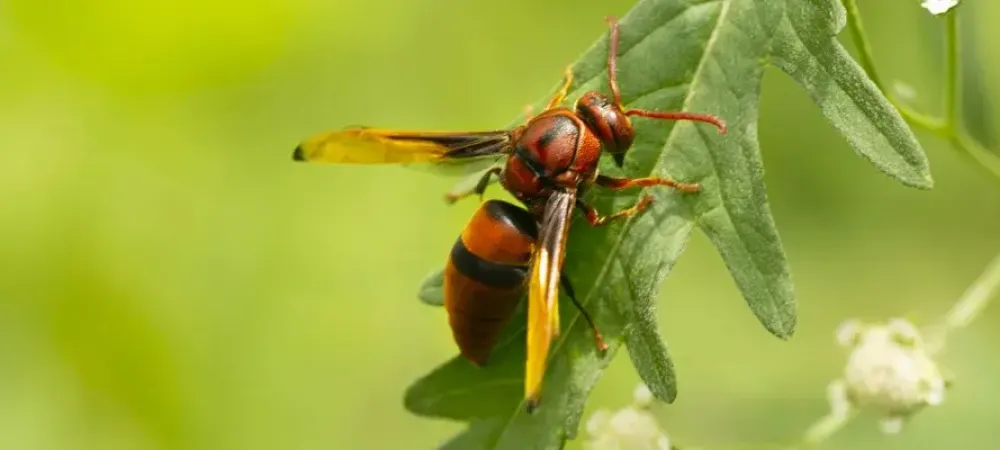The Texas Homeowner's Guide to Red Wasps

Red wasps, common in Texas, are both fascinating and, at times, intimidating. As part of the paper wasp family, they play a significant role in pest control by hunting other insects. However, their territorial nature and painful sting make them unwelcome around homes. This guide provides essential information about red wasps, from identifying and preventing them to safe removal strategies.
What Are Red Wasps?
Red wasps, scientifically known as Polistes carolina, are a species of paper wasp found widely in Texas and other parts of the southern U.S. Known for their rusty-red coloration, they are easily distinguished from other wasps. While generally not aggressive, they will defend their nests if they feel threatened.
How to Identify a Red Paper Wasp
- Color: Red wasps have a distinctive reddish-brown or rusty-red color on their body. Some may have black markings on the abdomen or thorax.
- Size: Adult red wasps are relatively large, measuring about 1-1.5 inches in length.
- Shape: Their bodies are slender with a narrow "waist" between the thorax and abdomen, with long legs that dangle during flight.
Red wasps are often confused with other types of wasps and hornets, so spotting their red color and longer legs can help you quickly recognize them.
Are Red Wasps Dangerous?
Yes, red wasps can be dangerous. Though they are generally considered less aggressive than other wasp species, they will sting to defend their nest, and their sting is painful. For people allergic to wasp venom, a sting can cause severe reactions, making them especially hazardous.
Red Paper Wasp Nests
Red wasp nests are made from a paper-like substance, constructed by chewing wood fibers mixed with saliva. The result is a structure with a series of open cells, resembling a honeycomb pattern, where they lay their eggs. Unlike hornet nests, which are fully enclosed, red wasp nests are open and exposed, with the cells visible from the bottom.
Where Do Red Wasps Build Their Nests?
Red wasps prefer sheltered locations for their nests, such as:
- Eaves and soffits: They often choose spots under roofs and overhangs, as they offer shade and protection.
- Garages and sheds: Openings in garages or sheds provide ideal, undisturbed spaces for red wasp nests.
- Trees and bushes: Red wasps may also build nests on branches or in dense shrubs, though this is less common near homes.
If you see a nest in any of these areas, it's likely within the range of your daily activities, which increases the risk of accidental disturbance and stings.
How to Prevent Red Paper Wasps Around Your Home
Preventing red wasps from nesting near your home can be easier than dealing with them after they've established a colony. Here are a few effective prevention tips:
- Seal Entry Points: Regularly check for gaps around windows, doors, vents, and attic openings. Caulking these areas will prevent wasps from getting inside your home.
- Remove Food Sources: Like most wasps, red paper wasps are attracted to sugary foods and liquids. Clean up spills, secure trash bins, and store food indoors to discourage their interest.
- Limit Outdoor Lighting: Wasps, like many insects, are attracted to light. Reduce unnecessary outdoor lighting near common nesting areas to make your property less appealing.
- Inspect Frequently: Regularly inspect areas around your home for early signs of nests. Early removal is easier and safer.
- Use Essential Oils or Sprays: Natural repellents like peppermint oil can help deter red wasps. Mix peppermint oil with water and spray around potential nesting areas.
How to Safely Get Rid of Red Wasps
If you've already spotted a red paper wasp nest on your property, follow these steps for safe removal:
- Use Wasp Spray: Commercial wasp sprays are designed to reach nests from a distance and kill wasps instantly. Stand 10-15 feet away and spray directly onto the nest during early morning or late evening when wasps are less active.
- Wear Protective Clothing: Even if you’re using spray, wear long sleeves, gloves, and eye protection to minimize the risk of stings if wasps get agitated.
- Remove the Nest: After ensuring all wasps have died, carefully knock down the nest with a long stick or broom. Dispose of it in a sealed bag to prevent re-establishment.
- Consider Professional Pest Control: If the nest is large or difficult to access, a professional pest control service can handle the removal safely and effectively.
When to Call a Pest Control Professional
Attempting to remove a large or hard-to-reach nest can be risky. If you or a family member is allergic to wasp stings, or if the nest is in a difficult spot, it’s best to call a pest control professional with the equipment and expertise to handle the job safely. Professionals also offer treatments to discourage wasps from returning to the same area, providing long-term relief from red wasps around your home.
Final Thoughts
While red wasps are beneficial for controlling other insect populations, they can be hazardous if they nest near human activity. By understanding where they nest and taking preventive measures, Texas homeowners can reduce the likelihood of red wasps settling near their homes. And, when necessary, safe removal techniques or the help of professionals can ensure a wasp-free environment.
For those looking for professional pest control from Corpus Christi to Harlingen, our team of local exterminators at Big M Pest Control is ready to help get rid of wasps and other yard pests. Contact our team to learn more!
